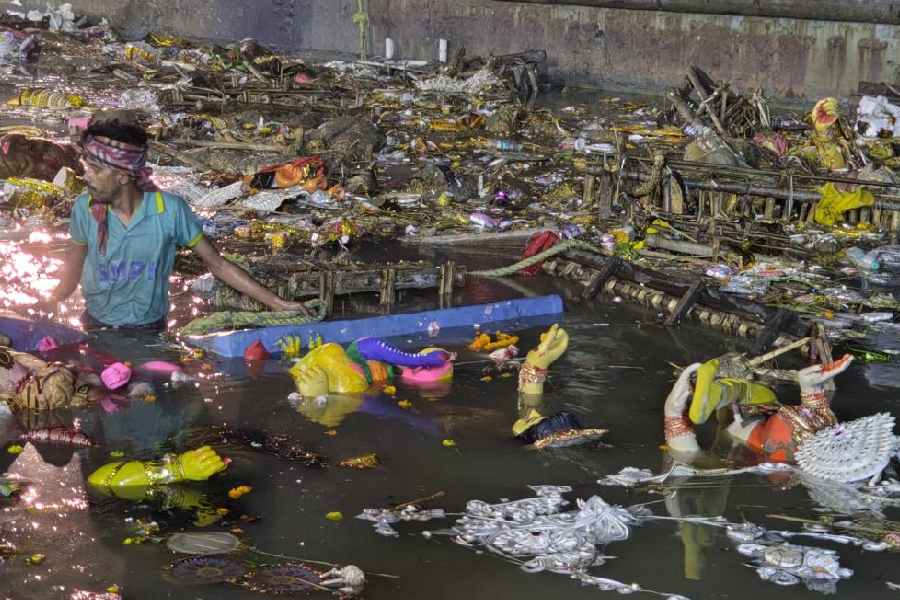Two cycles of low tide in the Hooghly on Sunday evening and early on Monday slowed the immersion of Durga idols, resulting in water pollution, environmentalists said.
Also, the absence of a system to lift the idols immediately after immersion at most of the 16 Hooghly ghats where the final Puja rituals are taking place is adding to the pollution peril, an expert said.
According to Kolkata Municipal Corporation (KMC) officials, three-fourth of the close to 4,000 pujas who immerse their idols in the Hooghly finished the rituals by Monday evening.
The officials said 806 idols were immersed at Gwalior Ghat on Sunday and Monday, followed by 604 at Baje Kadamtala Ghat and around 300 each at Ma’er Ghat andNimtala Ghat.
At Baje Kadamtala Ghat, a crane lifted the idols immediately after they were immersed to minimise the impact on the quality of water.
A crane was deployed at Nimtala Ghat, too, but it could not lift all the idols that were being immersed there because of paucity of space. To make up for that, the KMC had deployed workers to manually remove the idols.
At the other 14 ghats, all the idols were manually removed. “As a result, the idols were in the river for longer durations, resulting in the toxic chemicals and paints on the idols getting mixed with the water, especially during low tide,” said green activistSubhas Datta.
Officials of the KMC and the state pollution control board, independent experts and activists agreed that the immersion schedule should be linked to the tide timings as immersion during extreme low tide leads to a sharp rise in river pollution.
“Immersion during extreme low tide is a problem we have been facing over the years. The trend is continuing this year, too,” said Debasish Kumar, the mayoral council member in the KMC who looks after immersions in the city.
“The immersion slowed down for about two hours each on Sunday evening and early on Monday because of low tide,” a KMC official said. “We had to stop immersion for around 20 minutes on Sunday evening and early on Monday.”
Animesh Chattopadhyay, an organiser of the Maddox Square puja, said they had to wait at Baje Kadamtala Ghat early on Monday for several hours for the water level to rise enough so their large idol could be immersed.
“Immersion during low tide causes more water pollution. The impact is less during high tide because of dilution. Apart from affecting the river biodiversity, the pollution impacts us directly as many of the points from where water is collected and sent to treatment plants (which produce potable water) are located close to the immersion ghats,” said Arunabha Majumdar, a water pollution expert and a former director of the All India Institute of Hygiene and Public Health.
“Making the immersion schedule coincide with high tide will help reduce pollution in the Hooghly,” said Kalyan Rudra, a water expert and the chairman of the state pollution control board.
Krishnajyoti Goswami, a professor of biochemistry and an expert on lead pollution, said several peer-reviewed studies have shown that the levels of lead and other pollutants in the Hooghly water increased significantly during and immediately after immersion.










